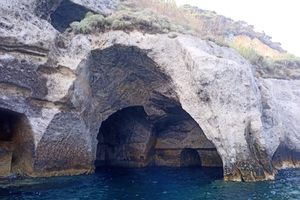Grotte di Pilato in Isola di Ponza, Italy

These caves located south-east of Ponza’s harbor are believed to be an elaborate example of a Roman fish farm.
The caves were dug into the island’s volcanic rock around the 1st-century CE, and formed five basins connected to each other via underwater passages. These were used to change the water and move fish and eels from one basin to another. Moray eels were greatly appreciated by Roman elites and the caves in Ponza seem to have served as farms for specific species of eels.
The position of the caves are below the remains of the imperial villa, which once belonged to Augustus and suggests the caves were for exclusive use.
Archaeological findings across the site include the 1997 discovery of a marble statue and several oil lamps. Archaeologists believe that the niches in the walls must have housed more statues, this suggests that the caves were also used for ritual or celebratory purposes.
The name of the cave is inspired by a local tradition that identifies Pontius Pilate (the governor of Judaea who presided over the trial of Jesus) as either a local Pontian or as having begun his early administrative career on the island, although historians disagree on the matter.





